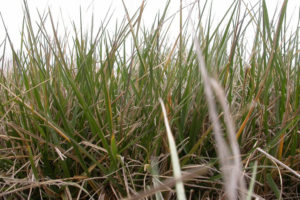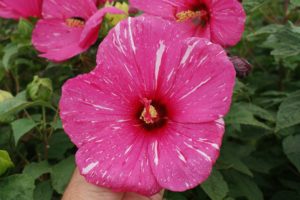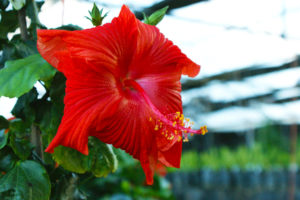Summary
Current Research
The Vernon Center’s Forage Breeding Program produces cool-season perennial forage grasses that are resilient to climate change in the Southern Great Plains. The ornamental plant breeding program has developed an array of novel flower colors in winter-hardy and tropical hibiscus species.
For information on licensing any of these plants, contact Janie Hurley at jhurley@tamu.edu or (979) 845-6337.


Cool-Season Forage Grass Breeding and Agronomy
We have introduced a new type of cool-season perennial grasses with summer-dormancy trait. These grasses originate from the Mediterranean Basin and are significantly better adapted to severe summer drought that occurs in the Southern Great Plains.
Why? In the 1970s and 1980s, temperate (summer-active) cool-season perennial grasses were introduced to the Southern Great Plains of the USA to complement forage for grazing cattle. Since the early 2000s, this region has experienced progressing drought due to increasing temperature and decreasing precipitation. A disturbed pattern of autumn precipitation has threatened timely planting of wheat, resulting in a lack of the major source of winter forage for grazing cattle.
The main objectives of the program are:
- Develop cool-season forage grass varieties resilient to climate variability in the Southern Great Plains
- Establish management practices of these new forages, including legume components of the mixed swards
- Incorporate new forage grasses into winter wheat-based grazing systems
- Characterize the mechanism of summer-dormancy in cool-season perennial grasses
- Identify physiological traits for selection of dual-use wheat with reduced bloat potential.
Our pioneer research on summer-dormant, cool-season grasses was initiated in 2001. Since then, similar programs have been established at the Noble Research Institute in Ardmore, Oklahoma and the University of Georgia at Athens. Our international collaboration with INRA (France), University of Jerusalem (Israel), and CSIRO (Australia) has resulted in a world-wide recognition of our research on summer dormancy in grasses.
Our summer-dormant grass breeding program is supported by a long-standing relationship with the industry partner, Grasslands Innovation (New Zealand).
In collaboration with scientists from the Noble Foundation Research Institute (USA) and Grasslands Innovation (NZ), we are developing the best management practices for this new forage grasses, including research on companion legumes, grazing tolerance, and tolerance to weed competition.
For detailed management practices of cool-season grass pastures, refer to these publications:
- Summer-Dormant Tall Fescue Management and Use for Texas. NRCS Technical Note TX-PM-12-01
- Flecha Tall Fescue User Guide for Texas and Oklahoma. Grasslands Innovation
- Prosper Summer-Dormant Tall Fescue. Barenbrug USA
Press releases about our Forage System Program:
- 2016 Summer-dormant cool-season grasses good option for perennial pastures. By Kay Ledbetter. Texas A&M AgriLife Communications.
- 2013 AgriLife Research develops new lines of cool-season grasses. By Kay Ledbetter. Texas AgriLife Communications.
- 2007 Seed the world. By Gail Lichtman. Scopus 24:20-22 (The Magazine of the Hebrew University of Jerusalem, Israel).
- 2007 Summer-dormant tall fescue grass shows promise for pasture improvement. By Kay Ledbetter. TAMU Agricultural Communications.
- 2005 Texas-Israel forage research could boost grazing options. By Tim W. McAlavy. TAMU Agricultural Communications.
- 2004 Vernon research targets sustainable forage systems. By Tim W. McAlavy. TAMU Agricultural Communications.
Winter-Hardy Hibiscus Breeding

SONY DSC
The late Georgia Bost, the “Hibiscus Woman” from Waller County, TX, believed that extensive hybridizing among native winter-hardy hibiscus species would eventually result in novel colors and color combinations. The idea was based on novel colors achieved in their distant relative, the tropical hibiscus (H. x rosa-sinensis) in the last century.
We have focused on creating as much genetic variability as possible, by inter-hybridizing several species of winter-hardy hibiscus. We evaluated more than 12,000 hybrids and disclosed over 280 unique lines to TAMUS Commercialization Office. A number of these lines are being evaluated by our commercial partners, and the first 10 cultivars will be available on the market in 2018.
We were the first to develop a blue-flowering winter-hardy hibiscus hybrid that we call “Blue Angel”. Based on the genetics of this cultivar, we have created about 20 other blue hibiscus lines with improved flower color, increased flower size, and more compact plant shape.
Other novel colors developed in our program include maroon, magenta, purple, mauve, fuchsia, salmon, and many dual and triple-colored combinations.
Our ultimate goal is to create hybrids with yellow and orange flower colors.
Examples of novel flower colors developed in our program:
- The hybrid 11418-1 has very unique dark-red veins
- Although pink color is common in winter-hardy hibiscus, the ruffled petals are a result of an induced mutation.
- An example of our earlier efforts to create a blue-flowering hybrid.
- Another example of a novel, bluish color in winter-hardy hibiscus.
- The flowers of this hybrid have a metallic tint which makes them very shiny.
- One of our best blue-flowering hybrids, 16565 GR.
- Dual-colored flowers are less common in winter-hardy hibiscus, and this hybrid takes it to a new level.
- Some hybrids have very large flowers, reaching almost 12 inches in diameter.
- A very unique shade of red color combined with ruffled petals is a result of an induced mutation.
- The first ever hibiscus hybrid in the AGGIE maroon color.
- This hybrid is the first step to create a salmon flower color.
- An extremely rare flower shape of winter-hardy hibiscus, resembling flowers of its distant tropical relatives.
- This hybrid is a very much improved version of the popular Texas Star hibiscus, H. coccineus.
- By selecting for wavy petals, we try to create hybrids with the illusion of a “full” flower.
- Another example of altered petal texture as a result of induced mutation in winter-hardy hibiscus.
- A very rare, magenta-colored flower of a winter-hardy hibiscus hybrid.
- Manipulating the petal texture may contribute to development of hybrids with the illusion of more than the regular 5 petals.
- Flowers with white eye are very rare in winter-hardy hibiscus.
- This line has the darkest plum flower color.
- An improved version of white Texas Star hibiscus.
- This novel salmon flower color is the first step to create flowers with orange color.
- One of our goals is to create hibiscus flowers with red petals and white eye. The white eye trait is highly correlated with pink petal colors; thus, it not easy to transfer the white eye trait to red flowers.
- Dual-colored flowers are very sought for in winter-hardy hibiscus.
- “Brandy Blue” is the first of our blue-flowering winter-hardy hibiscus hybrids that will be available in the USA in spring 2018.
- The coral-colored flowers of this hibiscus line are very attractive.
- Another example of a unique light purple flower color in winter-hardy hibiscus.
- “Crème de la Crème” with whiskered petals is another of our winter-hardy hibiscus hybrids that will be available in the USA in spring 2018.
- Another example of a hybrid with dual flower colors.
- One of our goal is to create winter-hardy hibiscus hybrids with a “batik” flower color pattern.
- One of the most dramatic examples of the novel, dual-colored hibiscus hybrids.
- Multicolored flowers are very rare in winter-hardy hibiscus.
- The cultivar “Robert Brown” is a very rare example of a chimera plant, where genomes of both parents did not fuse completely. Each flower of “Robert Brown” has a distinct pattern of white stripes on coral background, and any possible combinations of colors up to coral stripes on white background.
- Another example of a hybrid with dual flower colors.
- Adding some texture to the petals makes hibiscus flowers very attractive.
- A step in breeding a flower with red and blue petal colors.
- An interesting trait of fading colors of the eye of a hibiscus flower.
In response to the extensive hybridization, many of our winter-hardy hibiscus hybrids have started to develop flower color combinations that mimic these previously reported in tropical hibiscus, just like once suspected by Georgia Bost.
Examples of such a mimicry:
Press releases about our Winter-Hardy Hibiscus Breeding Program:
- 2017 The story behind the flower that amazed the world! By Michael Perry. Mr. Plant Geek.
- 2017 Colorful winter-hardy hibiscus hybrids continue trek to consumer gardens. By Kay Ledbetter. Texas A&M AgriLife Communications.
- 2016 Blue in town. By Leslie F. Halleck. Greenhouse Management.
- 2016 Expanding the horizons of our native hibiscus. By Brenda Beust Smith. Lazy Gardener and Friends Houston Garden Newsletter 170 (8/26/2016).
- 2015 AgriLife researcher develops a painter’s palette of winter-hardy hibiscus colors. By Kay Ledbetter. Texas A&M AgriLife Communications.
- 2014 AgriLife Research-bred winter-hardy hibiscus nearer to U.S. markets. Texas A&M AgriLife Communications. By K. Ledbetter.
- 2014 Lone Star State’s splashy winter-hardy hibiscus on track for 2015 sales. The Dallas Morning News. By M. Greene.
- 2012 Researchers take hibiscus efforts to commercialization. By Kay Ledbetter. Texas Agrilife Communications.
- 2010 AgriLife Research hibiscus breeder comes up with the blue. Rare hibiscus color is achieved after four years. By Kay Ledbetter. AgriLife Communications.
- 2010 White eyes, foot-wide flowers, maroon plants. AgriLife Research creating unique winter-hardy hibiscuses. By Kay Ledbetter. Texas AgriLife Communications.
- 2009 Unique winter-hardy hibiscus has roots with AgriLife Research scientist in Vernon. By Kay Ledbetter. Texas AgriLife Communications.
Tropical Hibiscus Breeding
 The tropical hibiscus breeding program was established at the Vernon Center in 2014. The main objectives were to create new flower and foliage colors and shapes, and plants with compact growth that would be more suitable for smaller gardens or as patio plants.
The tropical hibiscus breeding program was established at the Vernon Center in 2014. The main objectives were to create new flower and foliage colors and shapes, and plants with compact growth that would be more suitable for smaller gardens or as patio plants.
We have focused on creating in our hybrids as much genetic variability as possible, by inter-hybridizing several species of tropical hibiscus. Although this program is relatively new, we have already evaluated over 150 hybrids and disclosed 8 unique lines to TAMUS Commercialization Office. These lines are being evaluated by our commercial partners.
Examples of our tropical hibiscus hybrids:
- Tropical hibiscuses are bred for profuse blooming and compact plant shape.
- Tropical hibiscus hybrids have been created with all possible flower colors. Our goal is to create new color combinations.
- An example of a dual-colored tropical hibiscus hybrid.
- Warm, summer colors of flowers are very sought for in tropical hibiscus.
- Interspecific hybridization of tropical hibiscuses results sometimes in a quite new flower shape.
- An example of a more “primitive” form of tropical hibiscus.
- This tropical hibiscus hybrid is composed from three hibiscus species.
- An example of a dual-colored tropical hibiscus hybrid.
- Interspecific hybridization can sometimes bring quite unexpected results, for example, extremely small flowers.
- An example of a new flower shape resulted from an interspecific hybridization.
- One of our best interspecific tropical hibiscus hybrids.
- An interesting deep red flower color of this tropical hibiscus hybrid is combined with textured petals.
- Another example of flowers with a very nice, warm color combination.
Dr. Dariusz Malinowski

Dr. Dariusz Malinowski, plant physiologist, is a recognized world-wide authority on summer dormancy in cool-season grasses and mechanisms of mineral stress tolerance in cool-season grasses infected with Epichloe (formerly Neotyphodium) fungal endophytes.
His research focuses on adaptation mechanisms of forage crops to drought stress and management of forages in semi-arid environments of the Southern Great Plains.
For information on licensing any of these plants, contact Janie Hurley at jhurley@tamu.edu or (979) 845-6337.
Team Members
Taylor Fox, Research Technician
Publications
A systematic review on the effects of Epichloë fungal endophytes on drought tolerance in cool-season grasses. Frontiers in Plant Science. 2021.
Epichloë (formerly Neotyphodium) fungal endophytes increase adaptation of cool-season perennial grasses to environmental stresses. Acta Agrobotanica. 2019.
Designed and naturalized sward response to management: Patterns of herbage production. Annals of Applied Biology. 2019.
Insights into the drought and heat avoidance mechanism in summer-dormant Mediterranean tall fescue. Frontiers in Plant Science. 2017.
Responses of grassland communities to climate changes in Texas and Oklahoma. Proceedings of the 71st Southern Pasture and Forage Crop Improvement Conference. 2017.
Plant drought survival under climate change and strategies to improve perennial grasses. A review. Agronomy for Sustainable Development. 2016.
Grassland communities in the USA and expected trends associated with climate change. Acta Agrobotanica. 2016.
Find a comprehensive listing of Dr. Dariusz Malinowski’s publications at Google Scholar or ResearchGate




























































